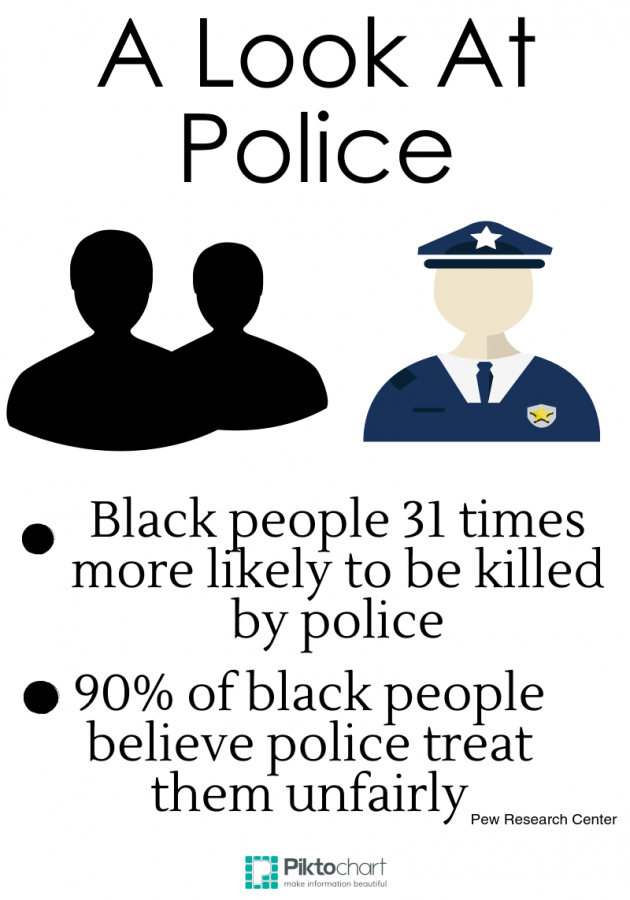On Aug. 9, police officer Darren Wilson stopped Mike Brown, an unarmed black teenager, and his friend, Dorian Johnson, while they were walking in the middle of the road. A scuffle quickly ensued between Wilson and Brown. Wilson maintains that Brown was charging at him and that he was sufficiently threatened to use lethal force. However, only one witness out of the 60 that were brought in front of the grand jury claimed that Brown posed a legitimate threat to Wilson. Wilson was acquitted.
Brown’s case should have gone to trial, but because of the ambiguity of conflicting witness statements, it is understandable on some level why the jury ruled the way that they did. However, what occurred just two weeks later was even more of a cause for reform.
The officer who choked Eric Garner to death while attempting to arrest him for selling untaxed cigarettes, the most nonviolent of crimes, was not indicted. Eric Garner’s case did not have the ambiguity that Brown’s case did. Garner’s death by a prohibited chokehold was caught on video and the facts are clear: Garner was not acting in a violent or threatening way and even after he was restrained on the ground, the officer continued to choke him. Even when Garner yelled that he was unable to breathe, the officer never loosened his grip. When they realized he had no pulse, no one performed CPR on him. Even though the autopsy report ruled his death a homicide, the officer was not charged for the act.
Much of the country has long been fed up with the current system in place that incarcerates more than a hundred thousand people from black communities for nonviolent drug crimes every year while allowing police officers to dodge legal consequences for brutality. For decades, people of color have suffered from the effects of an excessive police presence in their neighborhoods that breeds criminals instead of eliminating them. One’s skin color should not determine the kind of person they grow up to be, but racial biases, especially when it comes to police work, cause this to happen. Simply put, when people are treated like criminals, they are more prone to exhibit criminal behavior.
A recent study conducted by The Wall Street Journal shows that only about 10 percent of African Americans have confidence that police treat white and black people equally. If an average person visits any largely black city in the U.S., it is highly unlikely that they will find someone who has a positive view of law enforcement, and justifiably so, because police brutality is a pervasive issue in such areas. Many Americans believe that instead of serving citizenry, much of the police work in these areas has degenerated into blindly enforcing laws with a strict law and order mentality without taking into consideration the human cost.
However, many good cops in these cities are also often overlooked because of their negative counterparts. They often see themselves as being subject to harsh criticism by members of their community for things that they themselves did not do. In turn, even the best of cops often reduce to subconsciously discriminating against entire groups of people.
This distrust between both parties is a result of the vast gap in understanding between the police and the people they have sworn to serve and protect. There is a lack of empathy. It is especially harmful to a community if police officers lose their ability to empathize with the people that they serve and protect. The fact that Brown laid in the streets for hours before anyone bothered to attend to him illustrates this perfectly.
We often dismiss the idea that racial discrimination exists in our society and believe that the criminal justice system is immune to social biases even though it is quite evident that people of color are disenfranchised from basic privileges we so often take for granted. An innocent black man is also 31 times more likely to be killed by a police officer than an innocent white man, according to federal data. The truth is that we live in a society that recognizes race and makes decisions based on our own perceptions. We catch ourselves making assumptions about people because of their race and even laugh at the accuracy with which comedians portray certain stereotypes. Racial biases are an undeniable part of our culture because they are created in the presence of contrasting environments.
Most people who believe in the system, those who are usually exempt from excessive policing, have had positive experiences with law enforcement. And those who have not think of the system as the enemy. To these people, Brown’s death was not an isolated issue.
The disturbing truth is that there are only two people who knew exactly what happened that day: Darren Wilson and Michael Brown. And because Brown is not alive to be heard in court, Wilson has been given the unchecked ability to assert whatever he wants within the realm of material evidence.
The barriers that prevent social progress in our own community have been built by such notions as well. We have all judged people based on their appearance, social class, and even ethnicity. Race based assumptions and rumors spread like wildfire around campus behind the backs of those defamed. Peoples’ intelligence and demeanor are often all assessed by these factors, and when people are treated a certain way by the people they come in contact with, they will eventually become a manifestation of others’ beliefs about them. This is true for people of color who are treated a certain way by the system, and it is true for students at MVHS. To truly break through the racial barriers that we ourselves have constructed and made part of our ideologies, we must not completely become color blind, for that will infringe upon the notion of cultural individualism. Instead, we must all truly accept each other as human and as equals.








